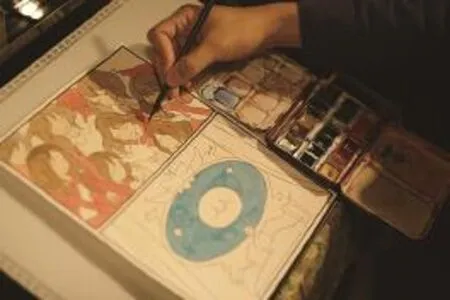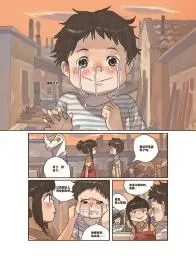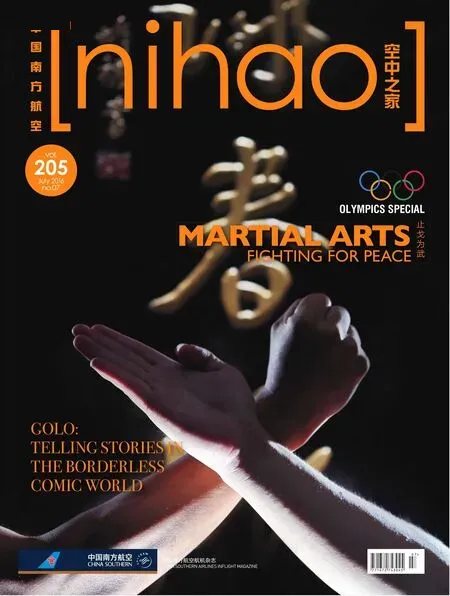高佬在无国界的漫画世界说故事
高佬在无国界的漫画世界说故事
在“2016中法之春”众多文化推广大使之中,80后的高佬大约是最年轻的一个。他所从事的漫画行业也更偏向于年轻人。在这个领域里,跨国间的互相交流与接纳似乎也更容易些。“只要你的故事、你想表达的东西,能够打动他们。”他说。
高佬无疑是具备了这种能力的。迄今为止,他已经在法国发行了16本漫画,是中国漫画家里最多的一个。
Among ambassadors of the Festival Croisements 2016, Golo, who was born in 1980s, may be the youngest.
The comics he is working on are also a youth-oriented cultural fi eld. In his view, both mutual communication and acceptance seem to be easier in this world of drawing and youth.
" So long as you have stories to tell or something to express, people get moved", said Golo.
Doubtless, Golo has this kind of ability. Up till now, he has released 16 comic books in France, which made him one of the top of Chinese comic artists.
1
On June 11th, Golo and comic artists from France and Belgium attended the Graphic Novel Festival and a series of forums. The Graphic Novel Festival is an important part of The Festival Croisements and also one of Golo's favourite activities. “Communicating directly with European artists of fi rst-class and being involved in different thoughts of creation and styles is an amazing experience.” he said.
Golo had interaction with European comics before. In 2011, through the companyTotalVision, he completed his fi rst comic book The Adventure of Ya-Ya with his French teammates. The comic book, which tells the story about two Chinese kids' adventure during in 1937 , was highly reviewed, which was followed with his continuous publications of six books.Interestingly, the conception and outline of the story was originally from a French editor Patrick , and the script, the samples of buildings and props of scenes were decided by Golo. “We discussed via Email and Video Interworking. From the beginning, there was a Chinese-French translator, but then we just started speaking English.”
However, this did not bring too many dif fi culties for his artistic work. “Children's worlds are very similar,. It's easy for them to tell black from white,” said Golo. This book is intended for 6 to 14-year-olds. Before reading The Adventure of Ya-Ya, most of them did not know that China and Japan once fought a battle. Ya-Ya is popular among youths. The different culture and special “scenes” are fresh and new to them.
Since the hit of Ya-Ya, Golo has published several comic books in France of various themes and styles. “This is also an advantage of the good publishing environment in France. Once they accept an artist, they will expect more possibilities, rather than the repetition of the former success.” Last year, he published his offprint book Hello, Vivian. The story happened in Colomiers, a small town in south of France, where only 60 thousand people are living. The impression there is quite different from what most Chinese think about France. There are few residents, and life is simple, maybe even tedium. Golo mentioned, even many French people don't know that place.
The different impression of Chinese on France arouses deep curiosity about other cultures. Nevertheless, Golo wishes to express something more personal but also somehow in common. “This is a story about a girl. She drifts about in a strange land. I hope someone who has a similar experience would understand that feeling, no matter where he or she comes from.”

2
The real name of Golo is Zhao Zhicheng. This Pseudonym originates from Cantonese and means the one who is tall.
He is Cantonese, but now he spends more time in Beijing. “In China, Canton has a huge comic market, Hangzhou is full of many creative artists, but in Beijing there are even more international cultural activities and more opportunities for cultural communication. However, with the development of Internet, everyone can live and coexist with each other in the virtual platform.” The situation of the comics in China changes very quickly; much information and various channels provide the emerging artists with many chances and possibilities.
Yet the so-called Chinese comics have not been well established. People from other countries know American comics and Japanese comics, but they have no clear image of Chinese comics. “This needs inheritance, accumulation and shaping, whereas the faundation in China is not fi rm enough,” said Golo. Japanese comics developed into a mature industry for many decades - the structure of storytelling, the procedure of creating, the format and size of the work, and even the pen, the ink and the paper are strictly spec ifi ed. Foreigners can tell Japanese comics from the fi rst sight. French call them “Manga”.
“But this requires time and a spec ifi c course.”Golo thought, “Finding out the system for yourself is the fi rst step.” Just like Hollywood fi lms, even if they are showing a Chinese story or Egyptian story, people can sense the American style. The expressions of comic artists doubtless project the cultural background they are living in. When more and more Chinese comics achieve worldwide reputation, maybe Chinese comics will rise a lot with a collected strength, as Golo said.
In international activities like the Festival Croisements, Golo keeps being exposed to and absorbing the inspirations from all over the world. “Chinese creation and imagination are poetic and abstract, while westerners lay more emphasis on reality. For instance, in one work of Francois Schuiten, he has his own theory, philosophical viewpoints and means of constructing the world, and can also precisely conform to the constructive principles, as architects have their professional abilities.
In future, he will try to put the inspiration he's got this time into his artistic work. He said, this is how he shows respect for masters.
1
6月11日,中央美术学院,高佬和来自法国、比利时的漫画大师们一起参加“图像小说节”系列论坛活动。“图像小说节”是“2016年中法之春”艺术节的重要组成部分,也是高佬作为推广大使最喜欢的活动之一。他说,“可以直接与欧洲国宝级同行交流,这种碰撞非常过瘾。”
此前,他与欧洲漫画界也早有交集。2011年,通过一家叫做“天视全景”的图书出版公司,他与来自法国的团队,一起完成了他的第一部作品——《丫丫历险记》。这本讲述1937年两个中国孩子历险故事——在真实时代背景下情节虚拟的漫画,在法国大受好评,随后又连续发行了后面的6本。
有意思的是,这个“中国”故事最初的构想和框架都来自于法国编剧Patrick,而高佬则负责故事的各种细节,包括建筑等资料的搜集。“我们的交流都是通过邮件、视频,最开始还有个中法文翻译,后来,我们就直接用英文沟通。”然而,这并没有给创作带来太大的困难。“在这个故事的理念里,我们着眼于主角的心路成长历程,孩子的世界都是一样单纯的。”高佬说。这本书的读者设定在6岁—14岁。在读《丫丫历险记》前,大部分孩子甚至不知道中国和日本打过仗。对于他们来说,亚洲是一块很陌生的土地。《丫丫历险记》里不一样的文化背景和历史“场景”,对孩子们来说很新鲜。
此后,他在法国出版了好几本漫画,都是不同的题材和风格。“这也是法国出版环境特别好的地方。一旦他们接受了某个创作者,就会希望看到他更多的可能性,而不是让他重复之前的成功。”他去年推出了一部叫《你好,薇薇安》的单行本,故事发生的地点是法国南部的一座三线小城科洛米耶(图卢兹旁边),只有6万人口。那里和大多数中国人印象中的法国很不一样,人很少,生活简单,建筑物方方正正,感觉很单调。高佬说,甚至很多法国人都不知道在哪儿。
这种与印象中法国的反差引发中国读者对异文化的深层好奇。不过,高佬说,他更希望表达一些很“个人”又很共通的东西。“这写的是一个女孩的故事,关于一个人在异乡的漂泊、遇见和成长的故事,我希望有类似经历的人,都能理解那份心情。”

2
高佬,真名叫赵智成。“高佬”这个笔名来自广东方言,意思是个子很高的人。
他是广东人,在北京电影学院毕业后,便一直留在北京。“在中国,广东是漫画消费大省,杭州集中了很多创意者,但北京有更多外事文化活动和文化交流的机会。”随着互联网尤其是电商的发展,国内漫画网络平台发展非常迅猛。“国内漫画环境变化非常快,资讯多,渠道多,给了新作者很多条件和可能性。”
然而,所谓“中国漫画”还未形成。外国人知道美漫、日漫,但对中国漫画没有印象。“这需要持续传承、积累、形成规模,我们的基石还不够深。”他说。日本漫画经过数十年的发展,才有成熟的产业——讲故事的结构,制作的工序,作品的规格尺寸,甚至画者用的笔、墨、纸都有专门的一套工具。外国人一看就知道是Manga(法国人对日本漫画的称呼)。
“都有一个过程,得慢慢来。”高佬说,“要先找到自己的体系。”就像美国好莱坞电影,哪怕呈现的是异国元素,人们从电影里看到的依然是美国精神。“漫画家的表达,必然带有他生存环境的文化。当越来越多的中国漫画家能在国际上有作品,或许,中国漫画就可以集点成面了。”高佬说。
在“中法之春”这样的国际活动中,他在不停地接触和吸收国际上的东西。“中国的创作想象比较写意,但西方更注重写实。这次中法文化之春图像小说节,我遇到比利时国宝级作者冯索瓦·史奇顿,他的代表作品《朦胧城市》,其中60%—70%的画面,都是想象出的未来建筑,架构严谨,充满了欧洲建筑派系朴实的光辉感,里面展现的哲学理论和人类环境学理念在漫画里是绝无仅有的。”高佬充满敬佩地说。
未来,他会尝试把这次受到的启发放在自己的作品里,他说,这是一种对大师的致敬。
N=NIHAO
G=GOLO
N: As an international cultural expression and a way of communicating, what kinds of advantages does the comic contain?
G: The advantage of the comic belongs to the communication of pictures, and when the readers see them, they almost have the same feelings. Some comics have even no dialogues, which override the obstacles of languages and optimise the translation of “meanings”. An English writer created the well-selling comic The Book of Bunny Suicides, in which there is not one single line, but only the really interesting plots. He talks about the sorrow topic of death that faces every human being yet in an extremely relaxing and joyful way.
NI: What do you think we can learn from the French on their cultural output and communication?
G: European comic culture is properly inherited. It has developed for over one hundred years. The Chinese comic culture is quite obvious. It happened once in the Republic of China and the again in the initial period of new China. We can see that the spirits and main ideas of the comic in the 60s, 70s and 80s are very different. Then in 90s, due to the awful social environment (for example the bad treatment of writers), the comic ceased to exist. From 2000 onwards, comic magazines gradually came back into people's lives and the real national comic then started to take shape. But these new comics have no inheritance from the last generation, and the shorcomings are very clear. I think the so-called cultural output lies in the successions, the continuous popularisation and stability. That's also on the top of our agenda and what we should learn from the French.
N: What's the difference between young Chinese and young French?
G:Young French emphasise the “ego” very much. When the author is working, he intends to show how“I” want to create, how “I” can relate my opinions to my readers. They pay a lot attention to the“formation of self cognition”. Many young French will make a random living for a while after graduation with the permission of their parents. They do parttime jobs and like to travel until they are in their late 20's or early 30's and then they start to think about settling down. During this period, they will see the different ideologies of other countries and build up their own values. I admire this kind of growing-up. We normally do job-hunting right after we graduate, and our family would permit nothing else. Moreover, China and France have totally different college entrance examinations. The examination in France requires much more philosophic thinking and open mindedness to argue many points. Philosophy is also part of students' curriculum. They put much importance on the abilities of independent thinking, self-thought and self-awareness. In contrary, what is our emphasis in China?
N: How has the attitude of young French towards China possible changed?
G:The young French I am getting along with know more about Chinese culture and the change in China than the elder French did. They get much more information on China and are amazed by the recent evolvement of Chinese online shopping. One of my French friends surprisingly realised that restaurants, hotels and CVS's in Beijing largely accepted WechatPay and Alipay, while people in France only pay in cash or with cards. As for the electronic reading, Chinese also reads more e-books than the French. In France, people prefer real books in their hands when they are on the metro.
“文化输出最关键是不能断层”

N: 漫画作为一种跨国文化的表达和交流方式,有哪些优势?
G:漫画的优势是图像的交流,当读者看到图像时,他们的感受基本是一致的。有的漫画甚至没有对白,这样就跨越了文字的障碍,得到“意义”的最大化传达。一位英国作家创作的畅销漫画《找死的兔子》,书本没有一句台词,但情节非常有趣,把“死亡”这个人类都面临沉重的话题,表现得异常轻松愉快。
N: 你觉得法国在输出和传播自己的文化上,有哪些值得借鉴的地方?
G:欧洲文化最优势的地方在于继承,即使是相对通俗的漫画文化,也在欧洲发展了一百多年,并且不曾出现任何断代现象。中国则是断层明显,民国断一次,建国后也是间断明显。我们可以看到,60、70和80年代的连环画,各自所传达的精神和思想差别非常之大。而到了90年代,由于社会环境的改变(比如作者的待遇变得越来越差),连环画甚至一度淡出人们的视线。2000年起,国内的漫画杂志慢慢起步,真正意义上的国产漫画才逐渐出现。但这时的中国漫画,已经跟作为它前辈的连环画没有任何关联了。所以,断代断得特别厉害。所谓文化输出,我认为关键在于不能断,必须持续地推广,保持稳定性。这是最重要,也最需要向法国借鉴的地方。
N:现在的法国年轻人与中国的年轻人有哪些差异?
G:法国的年轻人更强调“我”的思想。比如漫画创作者更多强调“我”想如何去画,“我”如何向读者表达我的观点。他们很重视“自我意识的形成”。很多法国年轻人大学毕业后会在家里人的认可下,先到外面闯荡一段时间,打零工,旅行,全世界到处跑,一直到28— 30岁,才会安定下来。在这段时间里面,他们会看到不同国家的意识形态,形成自己独有的价值观。我很羡慕这种成长方式。我们大学毕业后,第一件事情就是找工作,家里人更不可能支持别的选择。两国的高考题也很不同。法国高考需要对很哲学很开放性的命题阐述自己的观点,哲学也是法国学生的课程之一。法国对形成独立思考能力,自我思维、自我意识很重视。而我们重视的是什么呢?
N:年轻的法国人对中国的认知有什么改变?
G:我接触到的法国年轻人比他们的长辈更了解,也更感受到中国的变化。他们可以得到很多来自中国的资讯,他们惊讶于中国电商发展程度。我的一个法国朋友发现北京的饭店、餐厅、便利店,全部都可以用微信或者支付宝等软件支付时非常惊讶。在法国,人们只能用现金或者信用卡进行支付。阅读上来说,中国人也比法国人更多进入电子阅读模式。在法国,乘坐地铁的时候,大家依然是更倾向于手里拿着纸质小说来看。





GOLO'S PROFILE
高佬和他的纪录
2016
Ambassador of Croisements Festival 2016
担任“中法文化之春”形象大使
2015
Comic book Happy Ever Before published
Bonjour Vivian (Chinese and French versions) published
《你好,旧时光》(八月长安同名小说漫画版)出版
《你好,薇薇安》(中文、法文版)
2014
Golo's short story collection Waiting Alone published in Chinese and French
Dual language comic (Chinese and French) Between the Sky and Earth I published in the Francophonie
出版个人短篇集《独自等待》(中文、法文版)
中法语版《萤窗异草闻道集I》于全球法语区出版
2013
PRIX JEUNESSE Lyon BD 2013
Amien BD Festival Memorial Award 2013
Comic book of fi lm Up in the Wind
获里昂市漫画节青少年组最受欢迎奖获亚眠市漫画节纪念奖
创作同名电影《等风来》漫画版
获里昂漫画节年度青少年读物奖
2012
Lauréat LIVRENTÊTE 2012, Bande dessinée 9-11 ans
Sélectionné Meilleur 1er Album 2012 des lycéens picards
Lauréat Prix Bulles en Fureur 2012
获法国CBPT协会(法国全民图书文化协会)颁发的 “带头好书 ”奖(9—11岁年龄组)
安古兰国际漫画节入围学院奖
获法国关注漫画 BULLES EN FUREUR 奖
2011
Published La Balade de Yaya series (in French) and held booksigning meetings in 20 French cities
与法国出版社合作创作《丫丫历险记》,在法国二十余城市受邀请签售
GOLO TELLING STORIES IN THE BORDERLESS COMIC WORLD
Text by Brooke Translation by Bian Jiajin&Yi shan Photos by Bao Baolan
CULTURAL OUTPUT ALLOWS NO FAULTS

